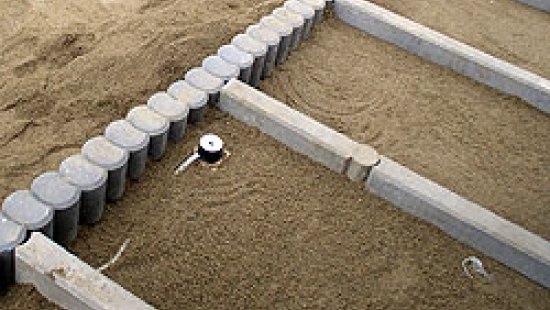Protection of outdoor areas against snow and ice formation

"Snow is falling, snow on snow…" – a beautiful winter idyll. Everyone certainly enjoys looking out of their window at snow-covered countryside. However, it is worse when you have to clean up this white "gift" in order to get to your doorway or garage. Probably everyone wonders while cleaning up the snow if there isn't a simpler way of getting rid of it. The answer is simple. Use heating circuits or ECOFLOOR mats.
A heating system installed in outdoor areas in connection with suitable regulation provides the permanent certainty that the required surfaces will be maintained snow and ice-free in the winter period. It is usually a fully automatic system which starts working when snow or sleet begins to fall and thus immediately prevents the accumulation of snow, and possible ice formation. This system is not just used for family houses or apartments. The heating of outdoor areas brings immense advantages and savings mainly in the public and industrial sectors. These days, we can commonly come across the heating of ramps, driveways, pavements, staircases, access ramps for wheelchairs, footbridges and bridges.
Planning and selection of a system
For the heating of outdoor surfaces, a surface wattage of 250–350 W/m² is usually selected. In the case of cable heating circuits, their linear wattage is 20–30 W/m. Particularly for these applications, we offer MST 280 W/m² and MDT 300 W/m² heating mats. Mats are produced with widths of 0.5 m and 1 m for operating voltages of 230 V and 400 V.
Regulation
For the regulation of outdoor surfaces, we recommend an EBERLE regulation set for open surfaces which contains an EBERLE EM 52489 regulator, an ESF 524 001 ice and snow sensor and a TFF 524 002 combined sensor of temperature and humidity. If the temperature sensor notes a drop in temperature below a set amount, and simultaneously, the frost and snow sensor notes the presence of snow or ice, the system begins operation. For the duration of snowfall or sleet, the heated surface is maintained above freezing point and ice doesn't form at all. If the snow melts or the temperature rises above the set temperature, the regulator will switch the whole system off. During very heavy snowfall, the snow melts away gradually and after it has finished snowing, the formed layer will melt as well. The heating system is only in operation for the necessary period and thus the operational costs are very low.
Methods of laying
MPSV heating cables and MST heating mats are usually laid into a 5–10 mm layer of concrete, upon which the floor tiling or another final layer is then laid. MST heating mats are produced from a one-conductor MPSV cable and thus they have two cold ends. To make laying easier, they are fitted with one 5m-long end, while the other end has a length of 5 m + the length of the mat. In this way, the second cold end has sufficient length to return from the most distant part of the mat back to the place of connection. MADPSP heating cables are two-conductor cables (and so have only one cold end). The cable has a robust construction with triple insulation and it is possible to lay it into concrete, sand and also directly into asphalt. MDT heating mats are produced from this type of cable, which is, due to its robust construction and the materials used, resistant to the high temperature of the asphalt during laying. Laying of the cable directly into asphalt will make the laying considerably easier and faster in comparison with other producers’ cables, which first need to be laid into a layer of concrete. With their products, only after sufficient hardening of the concrete is it possible to lay an asphalt layer.
An example of laying an MADPSP heating mat and heating circuit into sand under interlocking paving slabs
A compacted gravel base is covered with an even layer of assorted sand approx 3 cm thick. First, it is necessary to place the sensors in such a way that the frost and snow sensor is located outside the heating surface and the combined temperature and humidity sensor is within the heated surface. The heating mat, or heating cable attached to a Grufast strip, is then laid on the layer of sand. The heating cable and mat are covered evenly by another layer of sand approx. 3–5 cm thick into which the interlocking paving slabs are directly laid.
An example of laying a MDT heating mat in asphalt
It isn’t necessary to heat the full area of a driveway. The 0.5 m width of MDT mats is sufficient for the formation of defrosted tracks for the easy movement of lorries and semi-trailers even with steeper roads. A quality compacted gravel base is essential. The top base layer should be made of properly hard packed 0–32 fraction quarried aggregate.First, it is necessary to install the sensors. When laying mats into asphalt, it isn't possible to place the sensors there beforehand and so it is necessary to make casings which will be removed after the asphalt has hardened. The sensors are then covered with concrete in the created openings.
During the laying and subsequent rolling, there is a danger that the cable might be damaged by sharp stones in the base. Therefore, we recommend that a geotextile which will provide mechanical protection is laid under the mats. The first layer of asphalt needs to be applied to the mat manually, and it needs to be compressed with a manual vibration roller. The final layer of asphalt can be laid after the cooling of the first layer. It is possible to add this final layer with the help of heavy machinery.
And what is the result like?
Suitable dimensioning, accurate execution and the use of recommended regulation will certainly lead to the satisfaction of every user who has decided to employ this method of protecting open areas.


















